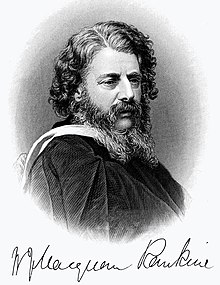William John Macquorn Rankine
William John Macquorn Rankine [ˈræŋkɪn] (born July 5, 1820 in Edinburgh , † December 24, 1872 in Glasgow ) was a Scottish physicist and engineer .
life and work
Rankine was the son of a Glasgow banker's daughter and a civil engineer and professional soldier. He went to school only sporadically, as he was ailing in his youth, and was mostly homeschooled, with an interest in mathematics becoming evident. After reading Isaac Newton's major work Principia at the age of 14, he began to be interested in physics. From 1836 to 1838 he studied science at the University of Edinburgh , where he won gold medals twice, once for an essay on the wave theory of light. In 1838 he left the university without a degree and became assistant to the civil engineer John Benjamin MacNeill (railway lines, port construction, canal construction), after he had already worked as a student on the construction of railway lines, which his father was in charge of. At the same time he began to publish works that were published, for example, by the Institution of Civil Engineers. In 1855 he received the Regius Chair for Civil Engineering and Mechanics in Glasgow. In 1857 he founded the Institution of Civil Engineers of Scotland (and therefore resigned from the London Civil Engineers Association) and became its first president (until 1870). Rankine's “manuals” on applied mechanics and civil engineering were a milestone in the engineering literature of the 19th century.
Rankine is one of the founders of thermodynamics and has made important contributions to the theory of the steam engine . He built on the work of Émile Clapeyron and Sadi Carnot . He also introduced the name energy for the fundamental physical quantity previously known under names such as “living force” and understood the transition to heat as the transition of kinetic energy into a form of potential energy (matter consisted of his then widespread mechanical conception of nature small vertebrae). His ideas on cyclic processes were similar to those of Rudolf Clausius ( Clausius-Rankine cycle ) and his thermodynamic work was taken up by James Clerk Maxwell .
Rankine also developed methods for calculating the distribution of forces ( statics ) in frame structures, studied the stability of walls in construction, the design and hydrodynamics of ships, and wrote about the fatigue of metals , e.g. B. on axles of locomotives.
There is an earth pressure calculation according to Rankine in soil mechanics . According to Rankine's theory of earth pressure (“Rankine's special case”), the course of the earth pressure on walls is calculated using the active and passive earth pressure, with the wall friction angles being zero, which represents a computational simplification.
In 1849 Rankine became a member of the Royal Society of Edinburgh , and in 1853 a member of the Royal Society in London. He was a member of the Royal Swedish Academy of Sciences and the American Academy of Arts and Sciences (1866). In 1857 he received an honorary doctorate from Trinity College , Dublin.
In 1859 he proposed a temperature scale. The Rankine scale is a temperature scale that, like the Kelvin scale, has its zero value at absolute temperature zero, but in contrast to this it uses the scale distance of the Fahrenheit scale . The distance of one degree Rankine ( unit symbol : ° Ra or, to a limited extent , ° R) is the same as the difference of one degree Fahrenheit , but the absolute zero point is 0 degrees Rankine or −459.67 degrees Fahrenheit. Rankine is not an SI unit . The Rankine scale was mainly used in Anglophone countries.
Rankine was also a gifted musician (cello, piano, vocals) who also published sheet music to accompany a piano song about railroads The Iron Horse . He also wrote humorous poems such as The Three Foot Rule Against the Metric System, which were collected and published after his death in 1874.
The Rankine moon crater is named after him.
Most important works
- Manual of Applied Mechanics (1858)
- Manual of the Steam Engine and Other Prime Movers (1859)
- Manual of civil engineering (1862)
- Machinery and Millwork (1869)
- Mechanical Textbook (1873)
- On the Thermodynamic Theory of Waves of Finite Longitudinal Disturbance , 1870, Philosophical Transactions, London / Edinburgh, Vol. 160, pp. 270-288
- Collected works
- On the stability of loose earth , Phil.Trans.Roy.Soc. Vol. 147, 1857, pp. 9-27 (earth pressure theory)
literature
- Cook Rankine and the theory of earth pressure , Geotechnique Vol. 2, 1949, p. 271
- Southwell Rankine, a commemorative lecture , Proc.Inst.civil eng., 1956, p. 178
- Achim Hettler and Karl-Eugen Kurrer : Earth pressure . Ernst & Sohn , Berlin 2019, ISBN 978-3-433-03274-9 , pp. 335–337
Web links
- John J. O'Connor, Edmund F. Robertson : William John Macquorn Rankine. In: MacTutor History of Mathematics archive .
- Article by / on William John Rankine in the Polytechnic Journal
See also
Individual evidence
- ^ Karl-Eugen Kurrer: Rankine's "Manuals" or: the harmony between theory and practice . In: History of structural engineering. In search of balance . 2nd, greatly expanded edition. Ernst & Sohn, Berlin 2016, ISBN 978-3-433-03134-6 , pp. 183-187 .
- ^ Karl-Eugen Kurrer: Rankine's stroke of genius . In: History of structural engineering. In search of balance . 2nd, greatly expanded edition. Ernst & Sohn, Berlin 2016, ISBN 978-3-433-03134-6 , pp. 320 f .
| personal data | |
|---|---|
| SURNAME | Rankine, William John Macquorn |
| BRIEF DESCRIPTION | Scottish-British physicist and engineer |
| DATE OF BIRTH | July 5, 1820 |
| PLACE OF BIRTH | Edinburgh |
| DATE OF DEATH | December 24, 1872 |
| Place of death | Glasgow |
